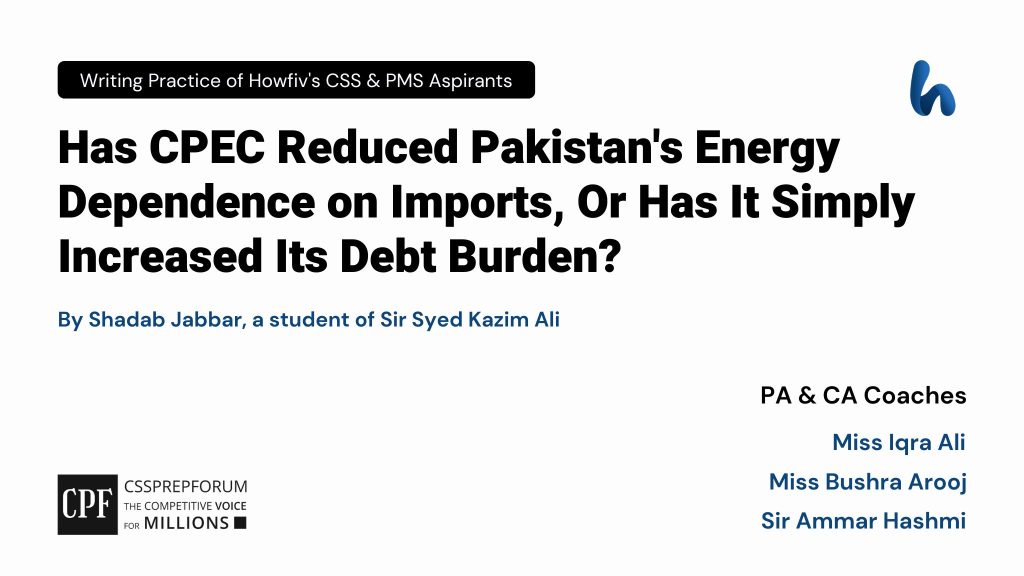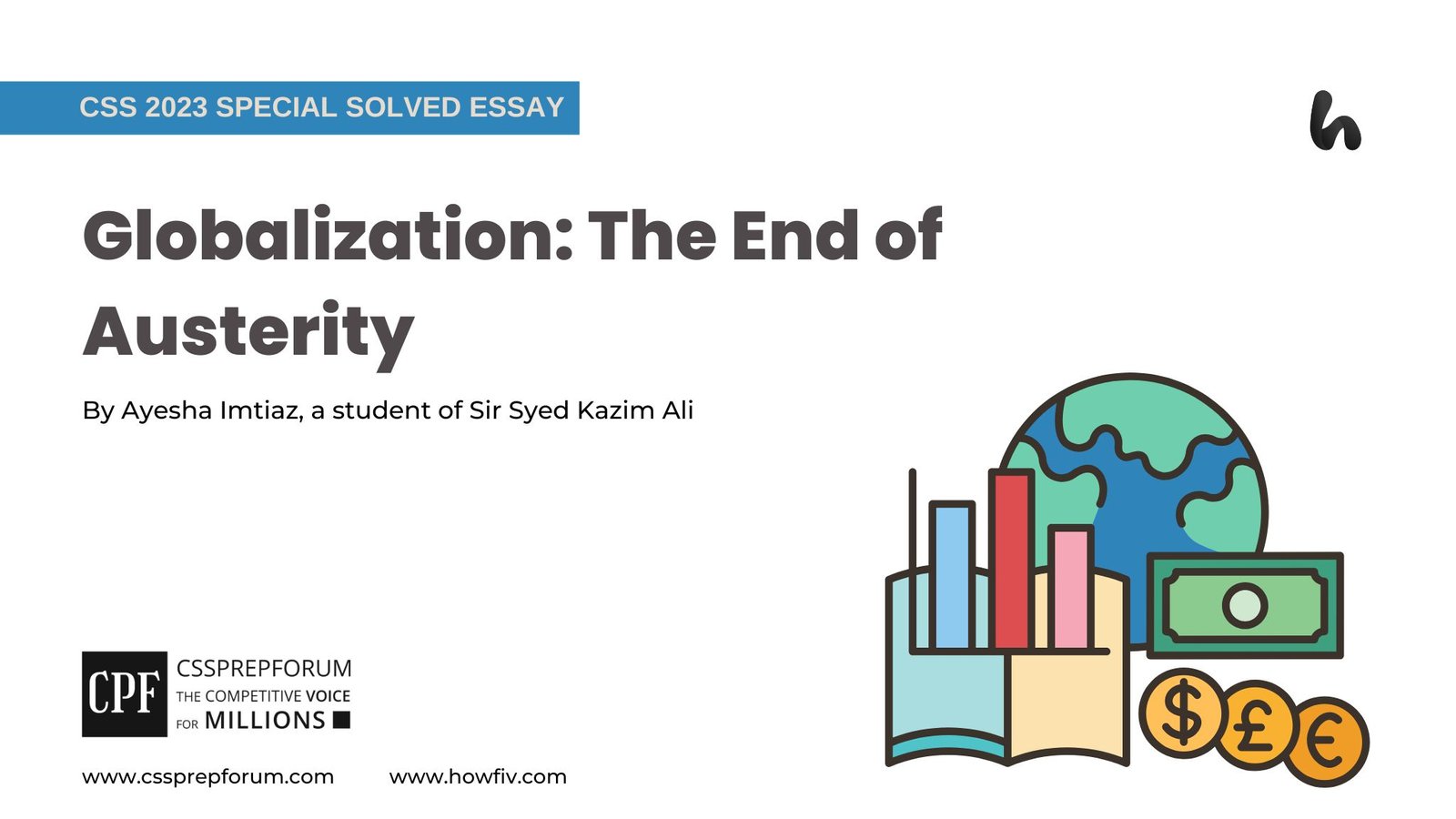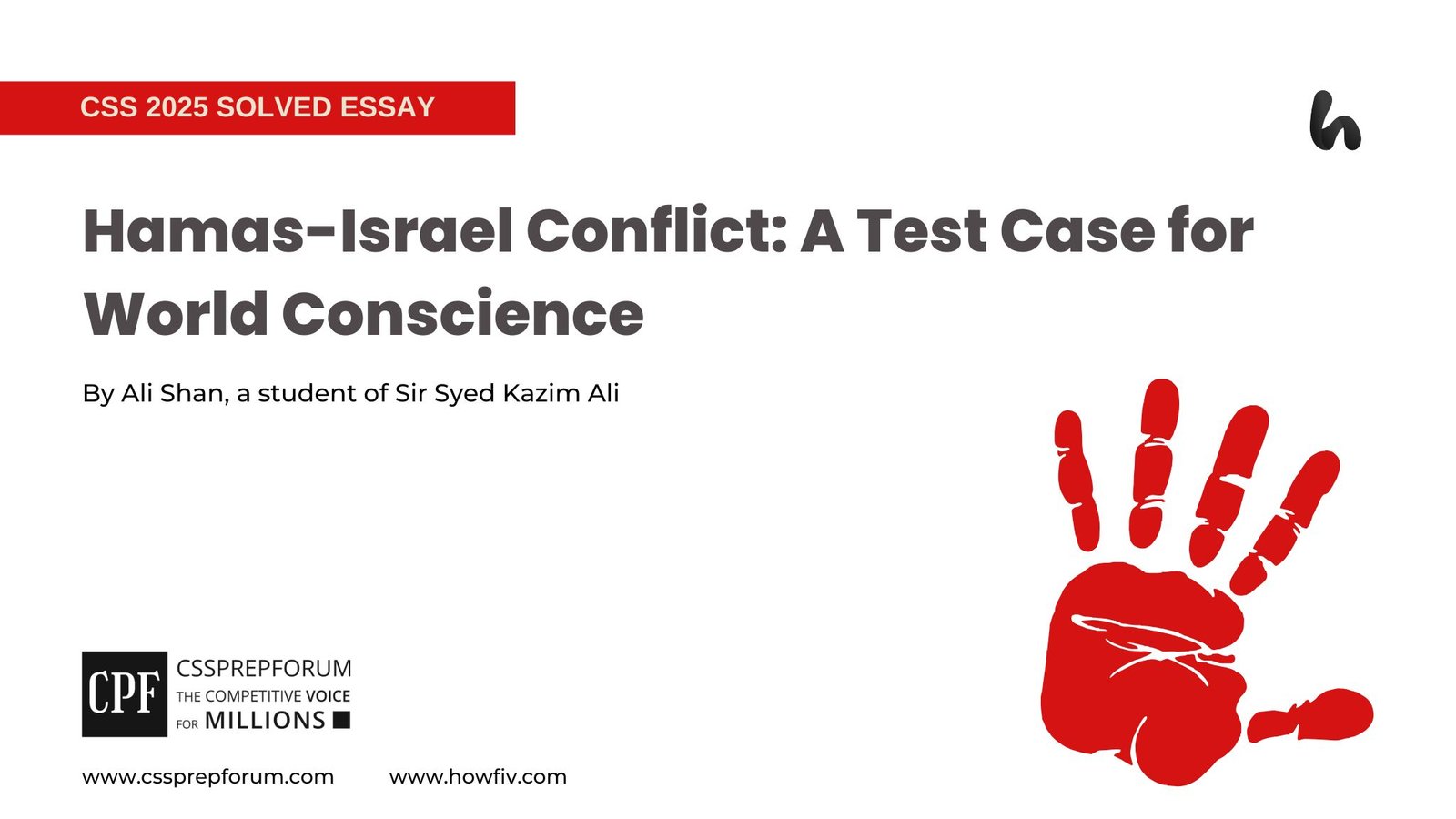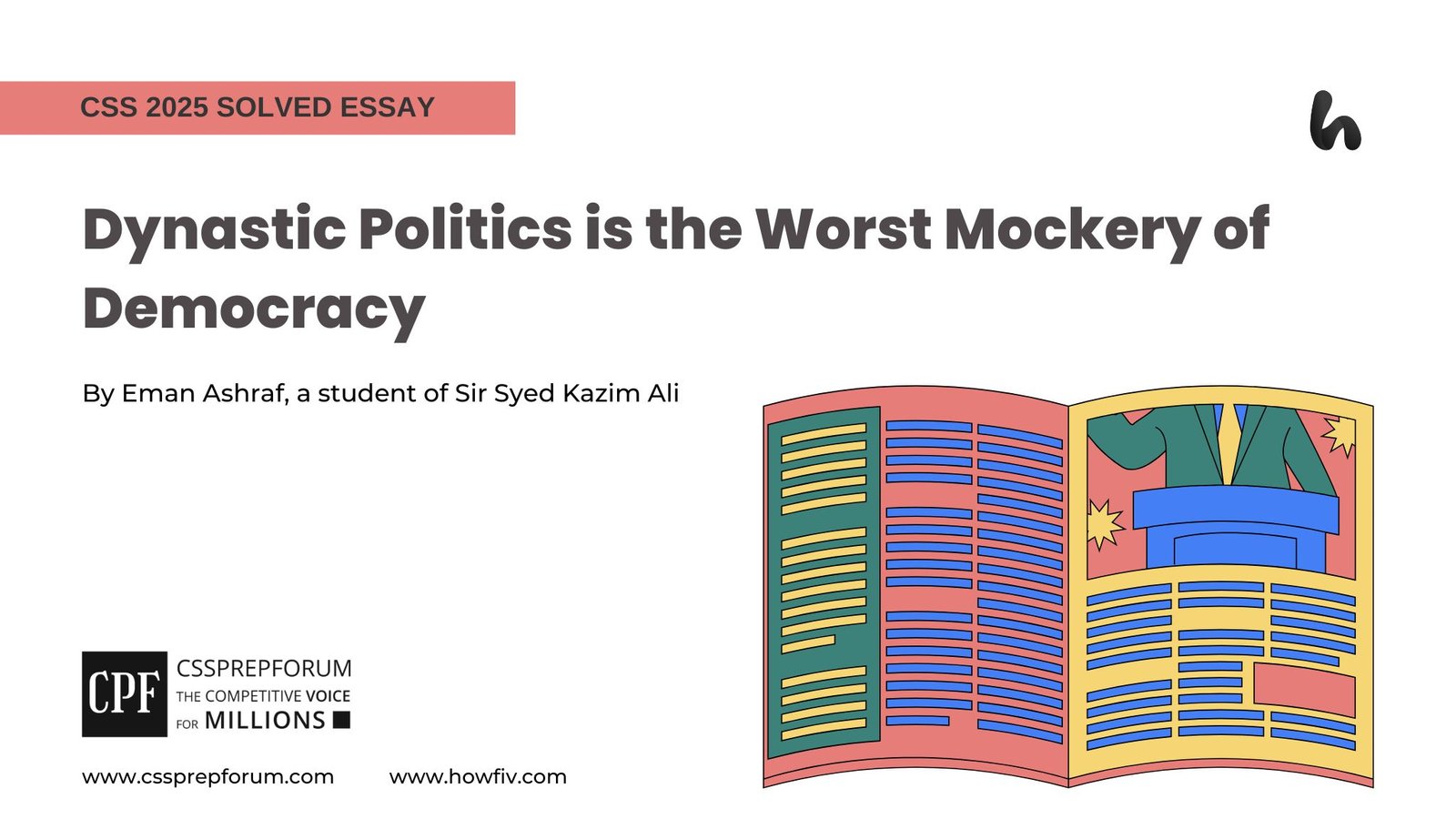CSS Pakistan Affairs | CPEC and Pakistan’s Energy Dependency
The following question of CSS Pakistan Affairs is solved by Shadab Jabbar under the supervision of Howfiv’s Pakistan Affairs Coaches. She learnt how to attempt 20 marks question and essay writing from Sir Syed Kazim Ali, Pakistan’s best CSS and PMS English essay and precis teacher with the highest success rate of his students. This solved past paper question is attempted on the pattern taught by Sir to his students, scoring the highest marks in compulsory and optional subjects for years, and uploaded to help aspirants understand how to crack a topic or question, how to write relevantly, what coherence is, and how to include and connect ideas, opinions, and suggestions to score the maximum.

Outline
1-Introduction
2-An overview of Pakistan’s dependence on energy imports
3-The manifestation of CPEC’s potential to enhance Pakistan’s energy security
- ✓Contributing to the national grid
- ✓Alleviating energy supply shortage
- ✓Exploring cheap indigenous sources of energy
- ✓Transitioning towards Green Energy
- ✓Promoting the flow of Foreign Direct Investment (FDI)
4-Criticism associated with the CPEC regarding the debt trap
- ✓A Neo-Imperial gambit
- ✓Independent Power Producers (IPP) ‘s overdue payments
5-Rebuttal: Debunking the debt fallacy
- ✓Not a debt trap
- ✓IPPs are older than the corridor
6-Conclusion

Answer to the Question
1-Introduction
China-Pakistan Economic Corridor (CPEC), the pilot project of China’s ambitious Belt and Road Initiative, launched in 2015, can potentially reduce the country’s energy dependence on imports. Fourteen of twenty-one energy projects under CPEC have been completed, contributing 20% annually to the national grid. Other than this, the corridor can aid in further making Pakistan energy-secure since it has the potential to help the country explore its indigenous energy resources. However, concerns have been raised because of Islamabad’s high debt-to-GDP ratio. The critics have displayed apprehensiveness regarding Pakistan falling into the vicious cycle of a debt trap due to the borrowed loans relevant to the CPEC. Conversely, the probable development, which the corridor holds the potential for, dims the mist of suspicion it carries. Although one cannot contradict the fact that the country is facing a significant debt load, it would be thus incorrect to attribute the burden solely to the China-Pakistan Economic Corridor.
2-An overview of Pakistan’s dependence on energy imports
For years, Pakistan has been in a tussle with the energy crisis. Resorting to the imported means has been one of the few options given the country’s low potential for production and the increasing energy demand. However, taking such measures to make ends meet is far from sustainable. The government has also been subjected to a persistent energy demand-supply gap fluctuating with the seasons. The Energy Outlook 2030 report by The Central Asia Regional Economic Cooperation Programme (CAREC) mentioned that Pakistan’s energy production comprised natural gas, oil, and coal. But, because of inadequate funding for research and development activities, the country is heavily dependent upon imports as about 40 per cent of the country’s primary energy supply is reliant on non-domestic means. In addition, the report also stated that in 2018, Pakistan’s energy demand was nearly 96 million tons of oil equivalent (TOE); however, the energy demand will keep rising further and amount to 108-126 million TOE by 2030.
3-The manifestation of CPEC’s potential to enhance Pakistan’s energy security
- ✓Contributing to the National Grid
Jumping towards the manifestations, the China-Pakistan Economic Corridor has undoubtedly enhanced Pakistan’s energy security through its completed projects in the energy sector, and it continues to do so with the projects under construction and consideration. According to the Chairman of the National Electric Power Authority (NEPRA), the energy projects under the CPEC umbrella, comprised of coal, wind, solar, and hydropower, have a total installed capacity of 6570 MW. In the Fiscal Year 2020-2021, they generated 28549.94 Gwh (gigawatt hour) of power, accounting for 22.03% of the total generation in Pakistan. Meanwhile, in the fiscal year 2021-2022, 25772.48 Gwh power was generated, making 18.37% of the country’s overall generated power. These projects thus have resulted in a 20% average annual addition to the national grid.
- ✓Alleviating energy supply shortage
Next, Pakistan welcomed CPEC amid its desperation to gain control over its energy crisis with unexplored energy resources and a lack of investments from relevant financial institutions. Islamabad also deals with a lasting gap in its energy demand and supply, which differs at different times of the year, depending on the shifting requirements. Furthermore, in 2013, the country took a significant blow to its production. The industrial and agriculture sectors suffered from insufficient energy, resulting from 16 18 hours of power shortages. Hence, Pakistan’s struggles with sufficient power generation paved the way for heavy reliance on imported fossil fuels to bridge the expanding gap. The economic corridor brought hope and promise of significant investments in the suffering energy sector with an agreement that all the projects would be completed in 2026. So far, the corridor has become a reason that the power shortages in the country have decreased, positively impacting the production in industrial and agricultural sectors.
- ✓Exploring cheap indigenous sources of energy
Moreover, the corridor has allowed Pakistan to explore better and more cost-friendly sources of energy production, such as coal and other renewable resources, rather than the much more expensive imported fossil fuels. According to government documents, Pakistan possesses “an enormous amount of untapped coal reserves.” For instance, there are approximately 175 billion tons of coal reserves in Thar. By effectively using the country’s extensive indigenous coal reserves, its dependence on the Gulf region for imported oil can be reduced.
- ✓Transitioning towards Green Energy
In addition, the China-Pakistan Economic Corridor has not only assisted Islamabad in looking into indigenous non-renewable energy resources but also aided it in turning towards more sustainable renewable energy resources, including wind, solar, and hydel, by making use of the county’s unused area for the projects. This will further enhance Pakistan’s energy security by providing cheap and clean energy to the national grid, as the country aims to produce 25% of its electricity requirements from renewable energy resources by 2030. To harness the renewable energy potential of the country and develop the energy sector, CPEC has established various projects: The Quaid-e-Azam Solar Power Part in Bhawalpur, the Dawood Wind Farm in Bhambore, the UEP Wind Farm and the J and Sachal Wind Farm in Jhimpur, the Suki Kinari Hydro Power Plant, the Karot Hydro Project, etc.
- ✓Promoting the flow of Foreign Direct Investment (FDI)
Lastly, the CPEC has enabled the Islamic Republic to attract tremendous investments from China and made the country a suitable place for other foreign investors, i.e., The Gwadar Port is a significant influx of Foreign Direct Investment (FDI). According to a senior official of the Chinese Foreign Ministry, “The projects under the China-Pakistan Economic Corridor are flourishing all across Pakistan and have attracted 24.4 billion USD of FDI from China for the last ten years.” Other than this, Islamabad is likely to get an investment worth 20 billion USD, out of which 10 billion USD would be invested in the Gwadar Oil Refinery as a manifestation of the Memorandums of Understanding (MOUs) it has signed with Saudi Arabia. Thus, the inflow of foreign direct investments and the profit they bring bring hope for Pakistan to become self-reliant when meeting its energy demand by increasing its investments in the energy sector.
4-Criticism associated with the CPEC regarding the debt trap
- ✓A Neo-Imperial gambit
Despite Pakistan being a primary beneficiary of China’s Belt and Road Initiative through the CPEC, there is considerable scepticism and suspicion regarding its effects on the country’s economy. The project’s critics, particularly those from the West, have called it a “debt trap” for Islamabad. They claim that the country will become a neo-colony of the People’s Republic of China and will get entangled in a debt trap because of the Chinese loans. While Beijing and Islamabad have fought to shape the narrative surrounding the CPEC, opposing observers point out that there is still much uncertainty regarding it, including conditions of loans and investments and overall cost to Pakistan. In fact, the US Department of State contends that the terms of the corridor are unsustainable for Pakistan, increasing its debt load and benefitting China only.
- ✓Independent Power Producers (IPP) ‘s overdue payments
Besides that, the Independent Power Producers have remained critical participants in the China-Pakistan Economic Corridor. Projects totalling about 8,000 megawatts of power have been successfully put into service by them. These projects meet energy demands using conventional, alternative, and renewable resources. However, there has been a mist of criticism directed towards the IPPs. For instance, sceptics argue that the Chinese IPPs negotiated advantageous terms, which have eventually led to increased dues to them by Pakistan. As of January 2024, Islamabad owed around 493 billion PKR to Beijing Power generation and transmission projects. Hence, the critics hold that the Islamic Republic cannot make these overdue payments at the heart of the corridor, and they will continue putting strain on its economy.
5-Rebuttal: Debunking the debt fallacy
- ✓Not a debt trap
However, the West’s anxiety regarding the China-Pakistan Economic Corridor as a neo-imperialist web can be negated as a misleading criticism based on a perceived fear of threatening the US-led World Order. It can be analysed from the State Bank of Pakistan’s data that loans from multilateral development partners, such as the Inter Monetary Fund (IMF), make up 53 per cent, while those from bilateral countries account for 22 per cent of Pakistan’s total debt. As of June 2023, Pakistan owed the IMF, Paris Club, and various international multilateral organisations 52.4 billion USD. On the other hand, bilateral deposits, which include Saudi Arabia and China, only make up 8 per cent of the total. These are one-year loans with a short duration that are taken out for financial help and balance payments. Meanwhile, China has developed a Debt Sustainability Framework under the Chinese Ministry of Finance and the Multi-lateral Cooperation Center for Development Financing to address debt sustainability concerns. If anything, it would be naïve to view CPEC as a bilateral government project designed to indebt Pakistan heavily.
- ✓IPPs are older than the corridor
Finally, the opposed analysts pose the introduction of the Independent Power Producers as a product of the CPEC, which is not the case. The IPPs have remained relevant in the energy landscape of Pakistan since the early 1990s. Furthermore, these actors filled the void in the energy supply chain by providing urgent power generation during the energy crisis. Although the financial challenges associated with the IPPs cannot be denied, it is essential to recognize that they are a part of broader governance issues rather than a consequence of the China-Pakistan Economic Corridor. Additionally, as of April 2024, Pakistan’s Ministry of Power has been instructed by the Federal Minister for Planning, Development, and Special Initiatives to promptly pay off the remaining dues relevant to the energy projects of the economic corridor, including the IPPs.
6-Conclusion
For decades, the Islamic Republic has been excessively dependent upon imports to meet its energy demand. Pakistan warmly welcomed the Pakistan-China Economic corridor in highly challenging times, hoping to enhance its energy security. The corridor has fulfilled its promise to a large extent with its numerous energy projects, many of which have been completed, adding about 8,000 megawatts to the national grid. Even though the CPEC has helped the country enhance its energy security, it is still subjected to a debt burden. Critics blame CPEC as one of the major culprits of the debt situation; however, their analysis is somewhat skewed and stands upon the insecurities.

CSS Solved Past Papers’ Essays
Looking for the last ten years of CSS and PMS Solved Essays and want to know how Sir Kazim’s students write and score the highest marks in the essays’ papers? Then, click on the CSS Solved Essays to start reading them.
CSS Solved Essays
CSS Solved General Science & Ability Past Papers
Want to read the last ten years’ General Science & Ability Solved Past Papers to learn how to attempt them and to score high? Let’s click on the link below to read them all freely. All past papers have been solved by Miss Iqra Ali & Dr Nishat Baloch, Pakistan’s top CSS GSA coach having the highest score of their students. General Science & Ability Solved Past Papers











